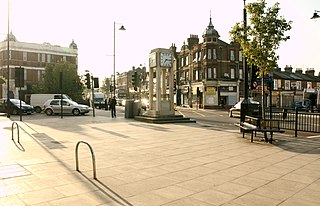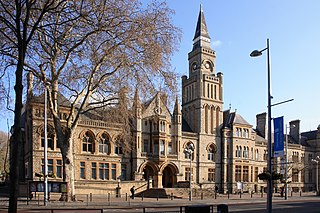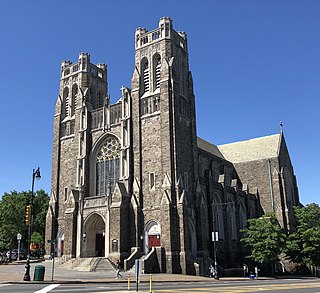
Great Ealing School was situated on St Mary's Road, Ealing W5 London and was founded in 1698. In its heyday of the 19th century, it was as famous as Eton or Harrow, being considered "the best private school in England". [1]

Great Ealing School was situated on St Mary's Road, Ealing W5 London and was founded in 1698. In its heyday of the 19th century, it was as famous as Eton or Harrow, being considered "the best private school in England". [1]
The school first took up residence in Ealing's Old Rectory. This was a moated house with a magnificent garden which stood next to the church of St Mary where Ranelagh Road now runs and all the way northward, along St Mary's Road to Warwick Road. The school had a swimming pool, cricket greens, tennis courts and the once famous Fives courts. A row of five cottages were used as studies. Opposite the school was the parish workhouse, where the poor and infirm slept three or more to a bed. [2] [3]
The future King of France, Louis-Philippe, taught mathematics and geography at the school. He did this to support himself whilst living in exile in Twickenham between 1800 and 1815. [4] Eventually, the Rectory succumbed to dry rot and had to relocate in 1847. [2]
It moved from the north side of St. Mary's Church in Ealing on the eastern side of St Mary's Road to the western side of the same road and was renamed The Owls, which then formed part of its crest. In 1874, it became a day school teaching vocational subjects such as bookkeeping. In 1879, it changed again, becoming a school for Jewish boys. [5]
It closed in 1908 and the roads Cairn Avenue and Nicholas Gardens now stand upon the grounds. The latter is named after the famous headmastering family of its greatest period. [5]

The London Borough of Hounslow is a London borough in West London, England, forming part of Outer London. It was created in 1965 when three smaller borough councils amalgamated under the London Government Act 1963. It is governed by Hounslow London Borough Council.

Hanwell is a town in the London Borough of Ealing. It is about 1.5 miles west of Ealing Broadway and had a population of 28,768 as of 2011. It is the westernmost location of the London post town.

Ealing is a district in West London, England, 7.5 miles (12.1 km) west of Charing Cross in the London Borough of Ealing. Ealing is the administrative centre of the borough and is identified as a major metropolitan centre in the London Plan.
The University of West London (UWL) is a public research university in the United Kingdom with campuses in Ealing, Brentford, and in Reading, Berkshire.

Ealing Art College was a further education institution on St Mary's Road, Ealing, London, England. The site today is the Ealing campus of University of West London.

Ossulstone is an obsolete subdivision (hundred) covering 26.4% of – and the most metropolitan part – of the historic county of Middlesex, England. It surrounded but did not include the City of London and the area has been entirely absorbed by the growth of London. It now corresponds to the seven London Boroughs of Inner London north of the Thames and, from Outer London, in decreasing order, certain historic parishes of the London boroughs of Ealing, Brent, Barnet, and Haringey.

Gunnersbury Park is a park in the London Borough of Hounslow between Acton, Brentford, Chiswick and Ealing, West London, England. Purchased for the nation from the Rothschild family, it was opened to the public by Neville Chamberlain, then Minister of Health, on 21 May 1926. The park is currently jointly managed by Hounslow and Ealing borough councils. A major restoration project funded by the Heritage Lottery Fund was completed in 2018. The park and garden is Grade II listed.
Brentford was a local government district in the county of Middlesex, England from 1874 to 1927.

Pitshanger is a small but busy local suburb, centred on the shops in Pitshanger Lane, located about 1 mile north of Ealing Broadway in west London. First mentioned in 1493, possibly meaning an area of sloped woodland frequented by birds. It contains numerous small independent shops, several cafes, two pubs, two churches, a school, and a park, and is often taken to also include parts of the nearby Brentham Garden Suburb.
The Cardinal Wiseman Catholic School, commonly known as The Cardinal Wiseman School, is a Catholic school comprising a comprehensive secondary school and sixth form located in Greenford, London, England. Its headteacher is Daniel Coyle and its student body consists of 11 to 19-year-olds.

Zachary Pearce, sometimes known as Zachariah, was an English Bishop of Bangor and Bishop of Rochester. He was a controversialist and a notable early critical writer defending John Milton, attacking Richard Bentley's 1732 edition of Paradise Lost the following year.

St Augustine's Priory School, is an independent Catholic girls' school in the London Borough of Ealing, England. It was founded and staffed by nuns from the priory, though the school has been run by a lay head since 1996. The school consists of Nursery (3-4) Prep, Junior (7-11) and Senior (11-18) departments and welcomes girls of all faiths. In 2014, it was in the top three best performing GCSE schools in Ealing.

Rawlinson Road is a residential road in North Oxford, England.
Events from the year 1752 in Wales.
Events from the year 1748 in Wales.

The Church of St. Nicholas of Tolentine is a Roman Catholic parish church under the authority of the Roman Catholic Archdiocese of New York, located at Fordham Road at University Avenue, in the Bronx borough of New York City, in the U.S. state of New York. The substantial stone twin-towered is deemed "The Cathedral of the Bronx."

St Peter's Church, Ealing, is an Anglican parish church in Mount Park Road, North Ealing, in the Diocese of London, regarded by Sir John Betjeman a church "of which we can justafiably be proud. Held to be one of the premier architectural works in Ealing, the Grade II* Listed building is noted for its combination of Arts & Crafts and late-Victorian Gothic as well as its west front and great west window. In addition to Sunday and weekday services, the church and adjacent hall serve as a hub for various community activities and events.

St Stephen's Church is a Church of England church on Castlebar Hill in Ealing. It was founded in 1867 as a mission and is now established as a separate parish. The first church building was a temporary iron church which was then replaced in 1876 by a substantial Victorian Gothic stone building which is now Grade II listed. Subsidence made that unsafe and it was deconsecrated in 1979. It has been converted to flats but still forms the landmark centrepiece of the St Stephen's Conservation Area. The congregation now holds services on the site of the church hall which has been redeveloped as the third church building and community centre.

The Grade I listed building Walpole House is the largest, finest, and most complicated of the grand houses on Chiswick Mall, a waterfront street in the oldest part of Chiswick. Both the front wrought-iron screen and gate, and the back boundary wall, are Grade II listed.

Little Sutton was one of the four constituent medieval villages of Chiswick, in what is now West London, and the site of a royal manor house, Sutton Manor, later Sutton Court. The great house was accompanied by a small hamlet without a church of its own.